Unwanted barking irritates owners and neighbours alike.
Some dogs bark a lot because of:
1. Boredom – the dog that’s home alone a lot
Breeds such as Border collies, Kelpies and Cattle dogs were bred to work and are happiest when they have a job to do. Their energy, stamina and intelligence is wasted when they are left alone with little to do for extended periods and they become bored and frustrated.
All breeds want to be with their pack, usually their owners, and become bored when home alone. Bored dogs bark, try to escape or are destructive, chewing hoses and shrubs or digging in the garden.
2. Anxiety – the dog that follows you everywhere
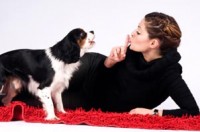 If left alone some individuals experience separation anxiety and bark for extended periods.
If left alone some individuals experience separation anxiety and bark for extended periods.
Other anxious dogs bark at threatening people or objects, such as the mailman or hot air balloons.
3. Disturbances – the dog that barks for 5 minutes when visitors arrive
Postmen, birds, passers-by and meter-readers set these dogs off. They then feel rewarded when the intruder leaves, apparently as a result of their barking.
4. Discomfort – the dog who starts barking unexpectedly
Barking from a normally quiet dog may indicate pain or an inability to access food or water.
5. Excitement – the dog that barks until you throw the ball
What you can do
Try to understand the cause of the barking so that you can choose the most appropriate solution from the table below. If you’re not quite sure of the cause try some of these solutions anyway – you might find one that works!
| Causes of barking problems |
Boredom |
Separation Anxiety |
Disturbances |
Discomfort |
Excitement |
| Possible solutions |
|
|
|
|
|
| 1. Exercise |
* |
* |
* |
|
* |
| 2. Training |
* |
|
* |
|
* |
| 3. Play toys/dogs |
* |
* |
* |
|
|
| 4. Hunting food |
* |
* |
* |
|
* |
| 5. Change of routine |
* |
* |
* |
* |
|
| 6. Veterinary care |
|
* |
|
* |
|
Solutions
- Exercise (for barking caused by boredom, separation anxiety, disturbances and excitement)
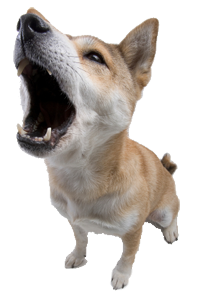 Dogs need exercise, some more than others. Working breeds require more regular exercise but even a couch-potato enjoys some outdoor entertainment. They all appreciate walks at different times of day and in variety of places, from the bush to the beach.
Dogs need exercise, some more than others. Working breeds require more regular exercise but even a couch-potato enjoys some outdoor entertainment. They all appreciate walks at different times of day and in variety of places, from the bush to the beach.
If walking the streets doesn’t appeal to you and your dog is friendly towards other dogs visit an off leash area. There he can play with other dogs or you can throw a ball or frisbee for him to chase.
Boredom is less of a problem in well-exercised dogs. Once home they are content to snooze or find a quiet activity.
2. Training (for barking caused by boredom, disturbances and excitement)
Training occupies a dog’s body and mind. It stimulates the bored dog and calms the overexcited dog.
The key to training is to find the most motivating reward. Food treats like dried liver or cheese are the number one motivator for most dogs. A special toy or praise works for dogs who are not food motivated.
Ask your dog to sit before every privilege, whether it’s a meal, titbit or ball game.
3. Play (for barking caused by boredom, separation anxiety and disturbances)
A play with puppy pals in the local dog park provides excitement and stimulation that will keep your dog quieter when he returns home.
Avoid play dates with other dogs if your dog tries to get away or squares up for a fight instead of play.
Most dogs love a ball or frisbee game with their carers.
At home rotate the toys you put out so that they retain their novelty value.
4. Food (for barking caused by boredom, separation anxiety, disturbances and excitement)
Games and food toys stimulate dogs as well as occupying their mouths so that they cannot bark!
Create a food hunt by scattering dry food around the garden or house. The hunt occupies their noses and minds as they search out every last biscuit. This is particularly good for the dog who has separation anxiety as it distracts their attention from the leave-taking.
Food packed or frozen inside toys that release it slowly, like Kongs and Treat balls, forces dogs to chew, paw and roll the toys around to extract the morsels of food.
Note that these foods are instead of, not in addition to, normal meals.
5. Change of routine (for barking due to boredom, separation anxiety, disturbances and discomfort)
Many dogs are comforted by routines. They like to know when to expect food and walks.
However, bored dogs want something different and stimulating – a walk at a different time of day or in a new location. Building a raised platform might also break the monotony for them.
Change your departure routine if your dog suffers from separation anxiety. Give him a toy or chew to keep him occupied. Scale down your goodbyes and returns by acting more casually. If he barks on your return ignore him until he quietens down then greet him calmly.
To prevent your dog reacting to predictable disturbances like the mailman, bring him inside or confine him to a different area.
You could experiment with blocking the sight lines of over reactive guard dogs.
6. Veterinary care (for bad cases of separation anxiety and discomfort)
Barking in a normally quiet dog may signal ill health.
Some dogs with anxiety related problems require medications in conjunction with tailored behaviour modification to learn calmness.
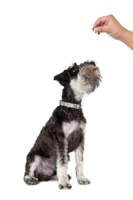 Start by holding a small piece of food near his nose so he can sniff or lick but not grab it. Slowly move it above his nose so that his nose is pointing in the air. Move the treat back over his head until his bottom is on the ground. As his bottom touches the ground say “sit” and give the treat. You are pairing the word “sit” with the action of sitting.
Start by holding a small piece of food near his nose so he can sniff or lick but not grab it. Slowly move it above his nose so that his nose is pointing in the air. Move the treat back over his head until his bottom is on the ground. As his bottom touches the ground say “sit” and give the treat. You are pairing the word “sit” with the action of sitting.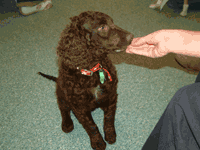 If you lower the treat too quickly the pup won’t follow the treat down and will lose interest. If you place the treat too far in front of his paws he will lean forward to get it and stand up.
If you lower the treat too quickly the pup won’t follow the treat down and will lose interest. If you place the treat too far in front of his paws he will lean forward to get it and stand up.
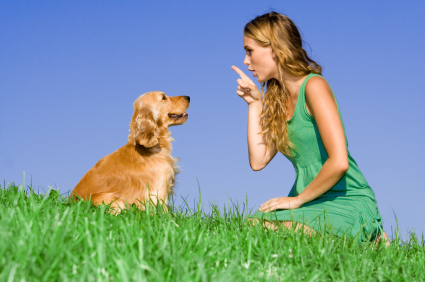
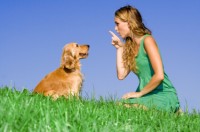

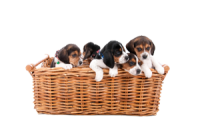
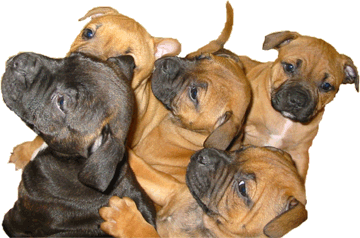
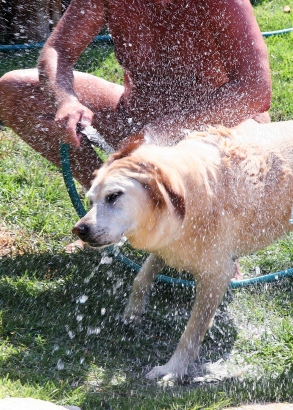 Do not bathe your dog more often than once a fortnight unless he has rolled in some unsavoury matter or your vet has prescribed a medicated shampoo.
Do not bathe your dog more often than once a fortnight unless he has rolled in some unsavoury matter or your vet has prescribed a medicated shampoo.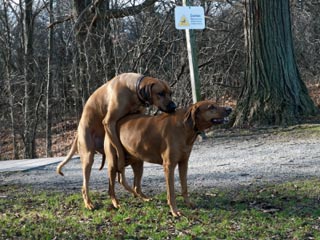 The hormone testosterone takes about a month to decline after castration. Once it is out of the system desexed male dogs are less likely to wander and have no interest in bitches on heat. Because they escape or wander less they are less likely to get run over, get involved in fights or lift their legs on every post.
The hormone testosterone takes about a month to decline after castration. Once it is out of the system desexed male dogs are less likely to wander and have no interest in bitches on heat. Because they escape or wander less they are less likely to get run over, get involved in fights or lift their legs on every post.
 Dogs need exercise, some more than others. Working breeds require more regular exercise but even a couch-potato enjoys some outdoor entertainment. They all appreciate walks at different times of day and in variety of places, from the bush to the beach.
Dogs need exercise, some more than others. Working breeds require more regular exercise but even a couch-potato enjoys some outdoor entertainment. They all appreciate walks at different times of day and in variety of places, from the bush to the beach.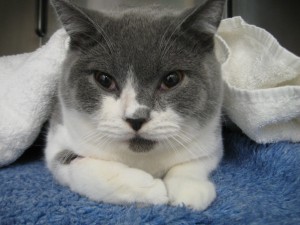
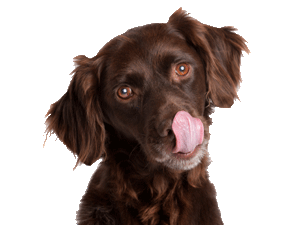 Coprophagia is the ingestion of a dog’s own or other pets’ faeces. While offensive to us it is normal for bitches with young pups and pups exploring their environment. It is only dangerous to dogs if they ingest parasites with the faeces. However, coprophagia in an older dog maybe an indication of a physical or behavioural problem and should be investigated by your veterinarian before trying the remedies listed below.
Coprophagia is the ingestion of a dog’s own or other pets’ faeces. While offensive to us it is normal for bitches with young pups and pups exploring their environment. It is only dangerous to dogs if they ingest parasites with the faeces. However, coprophagia in an older dog maybe an indication of a physical or behavioural problem and should be investigated by your veterinarian before trying the remedies listed below.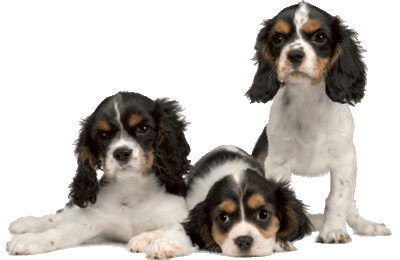
 Dogs play an important part in many of our lives. With proper training from an early age, they can learn to interact with people in a positive way.
Dogs play an important part in many of our lives. With proper training from an early age, they can learn to interact with people in a positive way.